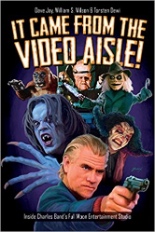
 In 2013, Dave Jay, Torsten Dewi and Nathan Shumate chronicled the long, strange trip of schlock-movie purveyor Charles Band in Empire of the ‘B’s. The only thing “wrong” with that book is that it ended with the collapse of Band’s Empire International Pictures studio, thus denying us the rest of the story: the indie legend’s pivot to the home-video biz under his Full Moon banner.
In 2013, Dave Jay, Torsten Dewi and Nathan Shumate chronicled the long, strange trip of schlock-movie purveyor Charles Band in Empire of the ‘B’s. The only thing “wrong” with that book is that it ended with the collapse of Band’s Empire International Pictures studio, thus denying us the rest of the story: the indie legend’s pivot to the home-video biz under his Full Moon banner.
Turns out they had a great reason for ignoring that second chapter: because it demanded its own book — and one even larger than the first. Now we have it in It Came from the Video Aisle!: Inside Charles Band’s Full Moon Entertainment Studio. From Schiffer Publishing, the hefty trade paperback is co-written by Jay, Dewi and William S. Wilson — the latter in for Shumate, who nonetheless provides occasional assistance as one of several other contributors.
While a sequel to the previous volume, Video Aisle approaches things a little differently, eschewing the title-by-title chronology in favor of divvying up its history lesson by whichever entity Band had convinced to fund his endeavors, from the highs of Paramount Pictures to the current lows of Band’s own wallet. It is a story of Hollywood-outsider hubris (or something close to it), with the rubber Band bouncing back from the theatrical detritus of his crumbled Empire Pictures by blazing a trail to direct-to-VHS product. Birthing the Puppet Master series, Trancers sequels and Stuart Gordon lit-horror adaptations, the results were — for a time — quite golden. Low in budget yet high (enough) in production value, these genre pictures found favor in the Blockbuster age and, in tacking VideoZone featurettes at the tape’s end to show how the sausage was made, Band built a fervent fan base as he presaged the bonuses appeal of the DVD format.
But the man’s title-and-a-poster development process could generate solid returns for only so long, and his quest to deliver more quantity than quality took its toll. Luckily, Jay, Dewi and Wilson do not shy away from being critical of the movies that demand and/or deserve it. Although their affection for the Full Moon brand clearly makes them more receptive to, say, Seedpeople or Shrunken Heads than the average bear, they don’t hesitate to call a turd a turd, and neither do the subjects they interviewed. The deeper into the page count (480!) the reader dives, the more of a lashing Band takes, particularly in his “personal penchant for minuscule monsters.”
Perhaps putting it best is effects man Tom Devlin (Unlucky Charms, Reel Evil, et al.): “Sometimes Charlie makes these decisions, most recently with the Gingerdead Man vs. Evil Bong movie, where he just won’t let some of the worst ideas go.”
Candor like that helps mitigate the one true fault of the book: photos so small, they strain the eye. For a project on a man who presold flicks that existed only as colorful artwork, it’s a shame we can’t revel in those visuals. Then again, enlarging them beyond their postage-stamp size might result in having to lose some of the material, which I would not be willing to do. Bearing well-earned stripes for completeness, It Came from the Video Aisle! covers seemingly everything there is to cover among Full Moon’s many phases: the Moonbeam line of kiddie films; the Torchlight Entertainment/Surrender Cinema line of softcore porn; the short-lived, William Shatner-hosted Full Moon Fright Night TV series; and — from Puppet Wars to The Primevals — even the movies that never had a fighting chance to be completed. —Rod Lott
